The firm of Thomas Tuckley, of Lane Head,
Willenhall was founded by Thomas Tuckley who was one of a large
number of members of the Tuckley family who were locksmiths in
the Willenhall area or approximately 250 years from 1726 to
1971.
The earliest Tuckley
lockmakers (18th century)
The earliest Tuckleys known
to have been lockmsiths were Humphrey [c.1718 to 1793] and his
brother John Tuckley [c.1718 to 1766]. How and where they
learnt their trade is not known. Humphrey Tackley [Tuckley] was
listed as a Box Lockmaker in the Willenhall section of the 1780
Pearson and Rollason Directory for Merchants and Tradesmen. This is
the first published reference in a directory to a Tuckley as a
lockmaker. John, in his will of 1766, was described as a Spring
Chest Locksmith.
Humphrey had four sons, all
involved in the lock industry in the Lane Head area: John (1740 –
1808), Thomas (1750 – 1822), William (1754 – 1793) and Joseph (1758
– c.1800. Humphrey, in his will of 1793, left land and dwellings at
Lane Head, and his tools, to his surviving sons John, Thomas and
Joseph; and legacies to his daughters.
John [1740 to 1808] was described in 1765 as a locksmith in the
Bushbury church marriage records. Professions were not usually
given in the marriage records of this period so it may indicate he
had some status in the community. William [1754 to 1793] moved from
Lane Head to Kidderminster in 1765, to Darlaston in 1766 and then to
Wednesbury between 1767 and 1769. In this period he seems to have
given up being a locksmith but he went back to the trade and did as
a locksmith. William's sons, who started the Tipton branch of the
Tuckley family, became coal miners and canal boat builders.
In the early 1800s there were six major Tuckley family groups
involved in lock making in the Lane Head, Short Heath areas of
Willenhall. They had large families and most of the people with the
name, who are still living in the Black Country area, are their
descendants :-
Sons of John and Mary (nee Tagg):
John [1766 to 1837]
Thomas [1773 to 1827]
William [1785 to 1850]
Sons of Thomas and Phoebe (nee Hartill):
Joseph [1775 to 1854]
Humphrey [1778 to 1853]
Isaac [1789 to 1870]
All are listed as locksmiths in trade directories for 1833, 1838
and 1845.
John Tuckley (1805 to 1878)
John Tuckley (1805 to 1878), the son
of John and Mary, locksmith, seems to have run into financial
problems. John took out a mortgage from a neighbour, Benjamin
Walker (a Willenhall butcher) in 1845, on his property at Lane Head
for the principal of £13 with interest of £5 per cent per annum. By
1847 he had not paid any interest and was being chased for the
money. In a note from John to Benjamin regarding his failure to pay
he says: "I can not get any place to go to and therefore I have no
desire whatever to defraud you I have been almost lost for [worry]
and not able to pay you any interest If please god things are better
I will pay some interest as soon as I can". He was pursued to
Walsall and Birmingham and served notice of a final warning. A
duplicate notice was served on John's neighbour, John Duncomb, who
was married to Elizabeth Tuckley and probably knew where John was
living. Benjamin was still not paid by 1854 and consequently he
gave John notice that "I shall proceed to sell the land and property
to recover my debt". John died in Birmingham in 1878.
George Tuckley (1818
to 1884)
George Tuckley (1818 to 1884), the son of Isaac and Mary, locksmith,
was living in New Invention in 1851 and 1861 and was employing two
apprentices. In 1870 he moved to Lane Head, perhaps upon the death
of his father, Isaac Tuckley. The 1871 Census lists George as
employing 9 men and 6 boys. Some of his boys came from the Workhouse
at Ampthill, Bedford. The indentures for three young boys who
were taken on as apprentice locksmiths to George Tuckley have
survived and are to be found in the Bedfordshire and Luton Archives.
Their papers state that their mothers were dead and that they had
been deserted by their fathers.
Alfred Jordan aged
15 years in 1865 bound for 5 years.
David Gudgin aged 13 years in 1871 bound for 8 years.
James Dudley aged 14 years in 1872 bound for 7 years
They were provided with
board and lodging and an outfit [clothes] but not wages. There was
correspondence in 1871 between the Master of the Workhouse at
Ampthill and George Tuckley, asking George to pay James Dudley a
weekly sum which should be increased annually when he reaches 17
years of age. George replied "that it is an imposition and he
cannot agree." However a year later he does agree "to have the boy
Dudley bound, [indentured] even though he is very unruly." A Dave
Gudgin, perhaps the former workhouse apprentice, was working at the
Thomas Tuckley lock works in the 1930s.
Thomas Tuckley (1815 to 1890)
|

Thomas Tuckley |
Thomas Tuckley
(1815 to 1890) locksmith, was the son of Thomas and Lucy
(nee Hawkins). He can be seen as the founder of the
firm of Thomas Tuckley, which continued at Lane Head
until 1971.
In later documents, the firm claimed
to have been founded in 1870. But Thomas seems to
have been carrying on a family firm which dates back to
round about 1765.
Thomas made locks in Short
Heath and the Census records show that he was employing at least 1
man in 1851, 1 man and 3 boys in 1861, 6 men, 2 boys in 1871 and 3
men in 1881.
In 1885 he
bought property, from a Mr. Appleby, at 1 Haley Street,
Lane Head and this is where he established his lock
works, where it continued until 1871, and where the
family lived.
|
| Thomas married twice and had one
surviving daughter from each marriage. After his death
in 1890 the eldest daughter Mary, together with her
husband Nicholas Crossley, carried on the lock business
and continued to trade as Thomas Tuckley, Lock, Latch
and Key Manufacturers. |
| In 1911, William Crossley, a son
of Mary and Nicholas, registered for the Company an
interesting trade mark in the form of a Boy Scout.
The design, which was registered in
September 1911 [No. 335295], was created by Charles
Knowles, one of Mary's sons in law. It appears to have
been used on all their paperwork, packaging and on their
locks. |
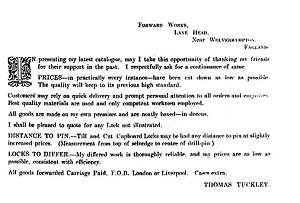
Front page of a
Tuckley catalogue, about 1912. |
|
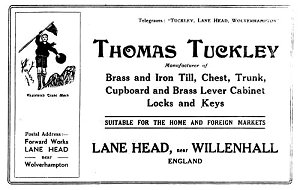
The scout logo from the same
catalogue. |
The Scout movement had been established in the early
1900s and by 1910 had overseas groups in Australia,
Belgium, Gibraltar, Ireland, Malta, New Zealand, South
Africa. Most commonwealth countries were excellent
markets for locks and in 1909 a three year export
agreement was signed by Henry Campbell of London and
Thomas Tuckley Lock Makers. It made Henry Campbell
their sole export agent in London and Australia. |
| This arrangement must have been a successful
arrangement because it was renewed in 1912 for a further
three years. |
| The Company employed a significant number of people,
perhaps up to 80, in the period between the wars.
During the 1939-45 War they employed 20 people.
After the war sales, through agents, resumed to such
places as Auckland, New Zealand (J Harrison and Son);
India (A.Murcotts & Co. Birmingham); Valetta, Malta
(Carmelio Delia); Johannesburg, South Africa (Oakden
Sons, London) |
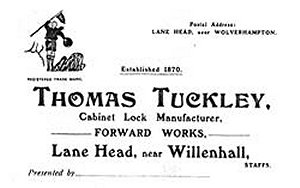
Business card
from the same period. |
|
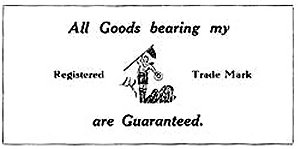
Guarantee, from the catalogue. |
In the 1961 Chamber’s Midlands Trades Register there
were 54 lock manufacturers listed in Willenhall, 10 in
Birmingham, 4 in Walsall, 1 in Wednesfield and none in
Wolverhampton. Only one firm with the name Tuckley was
listed in the Willenhall section and that was Thomas
Tuckley of Haley Street, Lane Head, Short Heath; they
were described as Brass and Iron Cabinet Lock and Key
Makers. |
| Overseas orders declined in the 1960s because of
cheaper foreign competition and the last order for the
Company was produced on 26th February 1971 for Rabone,
Petersen & Co. Ltd. of London for shipment to J.Harrison
& Sons Co., St Vincent in the Carribean.
Ron Bowdler took over part of the premises in the for
his turned parts business. |
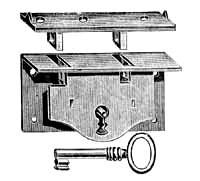
A Tuckley lock
from the catalogue. |
| However that is not the end of the Tuckley
connection with the Willenhall Lock Trade. Roy Tuckley
ran Tuckley Tools who were manufacturers of press tools,
jigs and fixtures for the lock industry. This firm
was restructured, in 2006, as T.W.H. Hardware UK Ltd.,
who continue the same business, supplying the lock
trade. |
The Thomas Tuckley Works
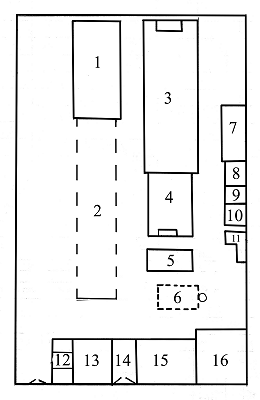 |
This plan, not to scale, shows the Forward Works as
they were when they closed.
At the bottom is Haley Street.
16 is the family house. Adjoining is the
building known as "The Warehouse" which contains 16: a
brass store downstairs and warehouse and office above;
14: a carriage arch entry to the yard; 13:
packing and despatch; and 12: three garages, originally
stables.
In the yard, 2 is the site of a wooden building
(demolished c. 1948) which was erected about 1860 and
originally contained the whole works except the
warehouse. |
| 1: "the Brass Shop" where all brass locks were
assembled. 3: Iron lock assembly and key
fitting shop, with a forge at the top end and four power
presses and various hand presses at the bottom end.
4: The tool shop, where tools were forged,
originally by hand methods. 5: The engine house (a
gas engine until 1935). 6: site of the steam
engine house. 7: The varnish house, unused
from the 1930s. 8: brew house. 9:
coal and coke stores. 10: scrap iron. 11:
toilets. The photos below show most of these features
but note that they were taken some years after the lock
works closed and the site had, in the intervening years,
been put to other uses. |
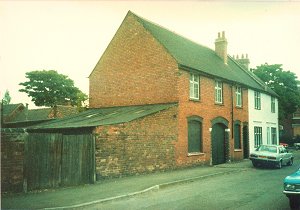 |
Haley Street, showing the family house at No.1 on
the far right, then the offices, entry, packing and
despatch and, nearest the camera, the stables/garages. |
| The house, seen from the rear. A small garden
area was fenced off from the rest of the yard. The
house is said to have been three storeys high
originally. |
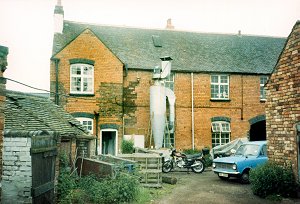 |
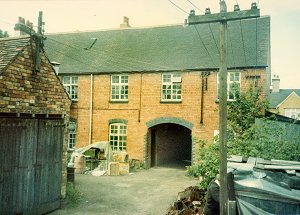 |
The warehouse end of the front buildings, showing
the carriage arch.
The warehouse building is said
to have been only one storey high originally.
The building on the left of the picture is the engine
house. |
| The iron lock assembly shop see from the warehouse
end of the site. |
 |
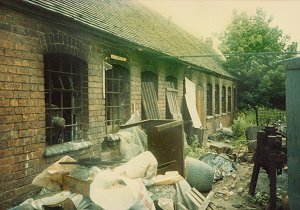 |
The same shop, seen from the other side and also
looking towards the back of the site. |
| The interior of the assembly shop. The
equipment shown is not what was there in Tuckley's time. |
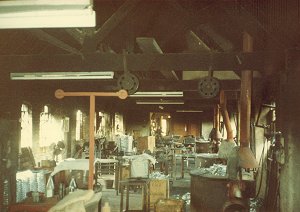 |
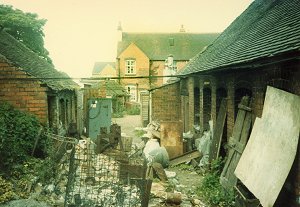 |
Looking towards the house from the rear of the yard,
showing the assembly shop to the right; and the old
varnish house, brew house and stores to the left.
|
 |
Return
to the
list of makers |
|